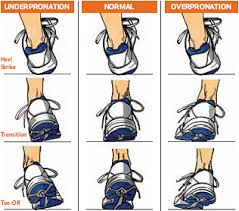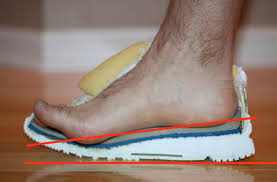
Tis the season of…..being awarded a London Marathon place.
I have certainly had a few patients recently as well as our own Physiotherapist Jade Blake, who have a place in next years’ London marathon or intend to do one of the many other spring, city marathons. That said, I thought it might be a good time to start pointing out the common problems a marathon runner is faced with and how to tackle them. This week I’m going to start with footwear. There are plenty to choose from, and with the recent trends in lightweight running shoes it’s difficult to know where to start. Choosing the right trainers is dependent on the combination of your foot posture and your running technique. Of course I am bound to tell you that a Physiotherapist is best placed to tell you what this is, and they are! I do have reservations about the level of analysis offered at shoe shops when recommending trainers for runners. The extent of ones anatomical and biomechanical knowledge is imperative if good quality advice is to be given.
Here are my key facts and advice;
1.) Foot pronation has been identified through much research as a significant factor in predisposing runners to injury. This is the inward rolling of your foot and this is a NORMAL movement just after landing. However, the degree of how much you pronate in the mid stance of running is what can be a problem. Excessive pronation does not necessarily mean you have “flat feet”, somebody with perfectly decent arches in standing may heavily pronate when running. Glutues medius strength and activation in running very often accounts for this as much as foot posture (another post altogether!). Many injuries are associated with over pronating; ITBS, achilles tendonitis, tibialis posterior dysfunction, hallux valgus, shin splints and many more. The problem with over pronating is that it means that forces are not distributed evenly through the foot and lower limb. Trainers designed to minimise pronation are built up on the medial side of the shoe to support the arch, often now referred to as motion control shoes for the severe pronator or stability shoes for mild to moderate pronation. They are generally heavier more cumbersome shoes and they can often feel “unresponsive” to the runner, especially those for excessive pronation. I do feel that these types of runners, would potentially benefit from custom made orthotics (insoles) which can be worn in a much lighter neutral shoe. That said, pronator shoes are improving and developments in materials used mean that the weight of these trainers are coming down.
2.) Foot supination is less common but is no more desirable than foot pronation, a common misconception amongst patients of mine in the past. This is where the foot does not roll in enough after landing making for a rigid landing and ultimately higher ground reaction forces transferring through the foot and tibia. If you supinate and don’t have any symptoms, your best bet is to aim for a highly cushioned shoe to minimise these forces, although the limitation of this are discussed later. If you think the supination may be extreme or are having symptoms I would certainly recommend considering orthotics, particularly if running longer distances.
3.) The benefits of heel strike vs forefoot running has been a huge area of debate amongst the Physiotherapy and Podiatry community. The answer is not clear cut and you could have me talking about this all day, but my thoughts are generally that running on your toes unless sprinting is not advisable. Midfoot running, where contact with the ground is first made just behind the metatarsal heads is however potentially beneficial, certainly up to 10km and for the right person, marathons too. Some people will naturally run with a midfoot strike but more common amongst adults is that the heel strikes first. Overall ground reaction forces and contact time are greater when heel striking and this can pre-dispose to injury. However, the biggest factor for me when I look at people running is the amount that I see runners over striding. Heel strikers that land as best they can underneath them (minimal over stride) with a good cadence are fine. However, more often than not, if you work on reducing the stride length you will achieve more of a midfoot strike. Now, back to trainers, where does this come in. Heel to toe drop is something you may have heard of, it just means the height of the heel in comparison to the toe. To transition towards a more midfoot strike in running a smaller heel/toe drop is preferable, something like 4-8mm. If you definitely heel strike and run at speeds such as 8.30 min/mile pace or slower I would stick to a larger heel toe drop i.e above 10 mm. However, if you are comfortably running a little quicker and would like to encourage a mid foot strike how about trying a lighter weight training shoe with a smaller heel toe drop for your shorter tempo runs (I will talk more about training programmes another time!) and then going back to your original favoured shoes for slower steady runs? The biggest thing here is transitioning. If you wish to make changes to your running technique, make them subtle and gradual, any change will be putting certain tissues in your body under different loads and the risk of injury could be increased if you go at it too hard.
4.) There is little evidence that cushioning of trainers makes any difference to injuries experienced by runners. This could be due to the soft tissue in your body having the unique ability to adapt to the forces it’s subjected to. And lets face it, foam based materials are going to do very little if you’re a heavy individual or you’re overloading a specific part of the foot due to suboptimal biomechanics. When it comes to cushioning, I would say go for what feels comfortable. For those speedier runners or those looking to encourage a midfoot strike, compare the degree of forefoot cushioning amongst trainers (ask in a good store or look online for stats) this can make quite a difference to comfort. I you’ve been running regularly for many years and have reasonable biomechanics you’ll probably find cushioning isn’t much of an issue for you. Probably the most important issue here is getting new trainers regularly enough. Materials in the shoes degrade over time, obviously more with use but also creep of the material means it will deteriorate even if sat in the box. It is not possible to say how frequently as this will vary depending on the trainer you’ve started with and the individual who’s running in them, but 500 miles is a rough guide. For marathon runners this will be around week 14 of a 20 week programme based on a 40 mile a week average. If your trainers weren’t new when you started your programme bear in mind when you’ll need to think about changing them. Have a look at the wear on them and go by how you feel, they may well need replacing before this.
5.) Lacing of shoes has been shown to have a small effect on foot control, particularly the amount of pronation as discussed earlier. Really what it comes down to is tying them up firmly (within comfort), if you’re pulling your trainers on without re-tying them, as you rush out the door for a run, they’re probably not tight enough. Different types of lacing will allow for tension to be maintained whilst running which could.
Well, I could go on, but I won’t. Post your questions and I can certainly do my best to answer them. Better still, come in and see me for a consultation, especially if you have early marathon niggles, prevention is always better than cure! As a Physiotherapist and runner myself and having completed London Marathon this year I have the unique blend of knowledge, passion and experience of running that could really help should you need it. For those who have a marathon place next year, congratulations and good luck.






